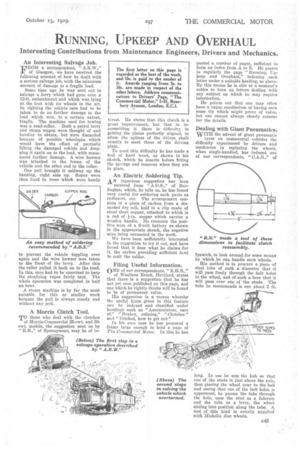RUNNING, UPKEEP AND OVERHAUL
Page 83

If you've noticed an error in this article please click here to report it so we can fix it.
Interesting Contributions from Maintenance Engineers, Drivers and Mechanics.
An Interesting Salvage Job.
M1ROM a correspondent, " A.R.W.," of Glasgow, we have received the following account of how he dealt with a serious salvage job, with the minimum amount of damage to a fragile load.
Some time ago he was sent out to salvage a lorry which had gone over a 12-ft. embankment and which was lying at the foot with its wheels in the air, In righting the vehicle care had to be taken to do no further damage to the load which was, to a certain extent, fragile. The machine used for towing was a road-roller. Both a petrol lorry and steam wagon were thought of and handier to obtain, but were discarded because of possible wheelspin which would have the effect of partially lifting the damaged vehicle and dropping it again on to the load, with consequent further damage. A wire hawser was attached to the frame of the vehicle and the other end to the roller.
One pull brought it midway up the banking, right side up. Ropes were then fixed to trees which were handy to prevent the vehicle toppling over again and the wire hawser was taken to the front of the lorry. After this the roller pulled it back on to the road. In this, care had to be exercised to keep the steadying ropes fairly taut. The whole operation was completed. in half an hour.
A steam machine is by far the most suitable for this or similar work because the pull is always steady and without any jerk.
A Morris Clutch Tool. TO those who deal with the clutches
of Morris-Commercial 25-cwt. and 30cwt. models, the suggestion sent us by " R.N.," of Spennymoor, may be of in terest. He states that this clutch is a great improvement, but that in re assembling it .there is difficulty in getting the plates perfectly aligned, to allow the splines of the driven shaft exactly to meet those of the driving plate. To meet this difficulty he has made a tool of hard wood, as shown in his sketch, which he inserts before fitting the springs and removes when they are in place.
An Electric Soldering Tip. AN ingenious suggestion has been received from " A.D.S.," of Burlington, which, he tells us, he has found very useful for soldering such parts as radiators, etc. The arrangement consists of a piece of carbon from a discarded dry cell, held in a clip made of stout sheet copper, attached to which is
a rod of copper which carries a wooden handle. He connects the positive wire of a fl-volt battery as shown in the appropriate sketch, the negative wire being connected to the work. We have been sufficiently interested in the suggestion to try it out, and have found that it does what he claims for it, the carbon providing sufficient heat to melt the solder.
Filing Useful Information. ONE of our correspondents, "R.H.B.,"
of Woollens Brook, Hertford, states that there is a suggestion that he has not yet seen published on this page, and one which he rightly thinks will be found to be of permanent value. His suggestion is a means whereby the useful hints given in this feature can be indexed and classified under headings such as "Accumulators, care of," "Brakes, relining," " Clutches " and "Ditched, how to get out." In his own case he has procured a folder large enough to hold a page of The Commercial Motor. In this he has pasted a number of pages, sufficient to form an index from A to Z. He pastes In regularly the page "Running, 'Upkeep and Overhaul," indexing each letter under a suitable heading, as above. By this means he is able at a moment's notice to turn up letters dealing with any subject on which he may require information.
He points out that one may often have a vague recollection of having seen some tip which might prove of value, , but one cannot always clearly remember the details.
Dealing with Giant Pneumatics.
WITH the advent of giant pneumatic tyres on commercial vehicles the difficulty experienced by drivers and mechanics in replacing the wheels, when single-handled, has induced one of our correspondents, " C.A.B.," of Ipswich, to look around for some means by which he can handle such wheels. His method is to procure a piece of steel tube of such a diameter that it will pass freely through the bolt holes in the wheel, and of such a bore that it will pass over one of the studs. The tube he recommends is one about 2 ft.
long.In use he sets the hub so that one of the studs is just above the axle, then placing the wheel near to the hub and seeing that one of the bolt holes is uppermost, he passes the tube through the hole, uses the stud as a fulcrum and the tube as a lever, the wheel sliding into positioh along the tube. A. tool of this kind is usually Supplied with Michelin disc wheels.




























































































































